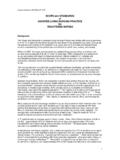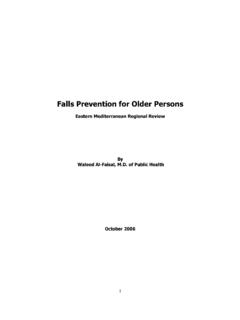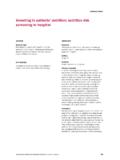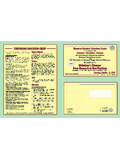Transcription of A Patient Handling and Movement Needs …
1 A Patient Handling and Movement Needs assessment toolkit James W Harrell, FAIA, FACHA, EDAC, LEED AP. Senior Medical Planner PDT Architects LLC. Regan Henry, PhD, AIA, LEED AP, GBSS. Project Architect PDT Architects LLC. 1. Author bios Author Contact James W Harrell, FAIA, FACHA, EDAC, LEED AP. Jim Harrell has 53 years of experience in medical programming, space James W Harrell, planning, and design. As a Senior Medical Planner at PDT Architects, LLC, FAIA, FACHA, EDAC, LEED AP. he is exclusively focused on creating innovative healthcare environments Senior Medical Planner - from ambulatory care to critical care design.
2 Mr. Harrell is a founding PDT Architects LLC. member of the Committee to Recommend Standards for Newborn ICU 300 West Fourth St. Design. He helped draft the SCCM design standards for ICUs and recom- Cincinnati, Ohio 45202. mendations for women's healthcare environments. He contributed to the 513 891 4605. FGI 2010 guidelines language for safe Patient He is a frequent speaker at healthcare design symposia and a contributing writer for healthcare design publications. Regan Henry, PhD, AIA, LEED AP, GBSS. Regan Henry brings a unique perspective to healthcare design through Regan Henry, her background as a scientist.
3 Dr. Henry received her undergraduate and PhD, AIA, LEED AP, GBSS. master's degrees in architecture, but then went on to receive her PhD Project Architect in molecular biology. After working for years in a laboratory, publishing PDT Architects LLC. and teaching in higher education, she returned to architecture seeking to 300 West Fourth St. meld her two interests. Her work follows research based design princi- Cincinnati, Ohio 45202. ples and seeks to engage all vested parties in the design process. She 513 891 4605. appreciates that a good design process is a teaching and learning tool for both client and architect.
4 2. Abstract The FGI Guidelines, 2014 edition, stipulates that the governing body of the health care facility provide a Patient Handling and Movement Needs assessment (PHAMA) to the design team on facility improvement projects. A PHAMA is intended to evaluate the Movement and Handling of patients in order to assess safety risk - for patients and staff - and identify best practices. This is an integral part of the pre-design functional and space programming process. It should be updated as new information becomes available during throughout project design, construction, and commissioning.
5 PHAMA recommendations and revisions are intended to inform the design about Patient Handling and Movement (PHAM). equipment and associated accessories to be used in specific locations. Such advice includes information about any spatial, structural, utility or design considerations related to installation, use, and servicing of such equipment. Many healthcare providers have adopted policies and procedures for safe Patient Handling and mobility, but it is unclear how many design projects are implemented using a PHAMA. There are a number of states in which the preparation and use of a PHAMA occurs rarely, or not at all.
6 In this White Paper we will elaborate upon the FGI's recommendations by discussing specific factors to be addressed in a PHAMA and draft sample PHAMAs for a variety of spaces and high risk Patient populations. It is our aim that this White Paper be used as a tool for hospital administrators and designers as they draft PHAMAs for their respective projects. Keywords: PHAMA, stipulate, safety risk assessment , design, toolkit . Category: Education 3. Introduction The Facility Guidelines Institute (FGI) Guidelines stipulate that a Patient Handling and Movement Needs assessment (PHAMA) be completed to address issues with Patient mobility when embarking upon a facility improvement project.
7 PHAMA is intended to evaluate the Movement and Handling of patients in order to assess safety risk - for patients and staff - and identify best practices. In this paper we hope to stress the importance of preparing a PHAMA by introducing the at-risk populations it serves, defining the existing issues with servicing these populations and providing solutions for both equipment utilization and policy adaptation that may contribute to improved Patient safety and mobility. At Risk Patient Populations Increasing numbers of the population are considered obese, disabled and/or elderly.
8 All three of these characteristics are associated with decreased mobility. This changing Patient demographic has implica- tions on how services are rendered within the healthcare industry. The following is a list of Patient populations shown to have mobility challenges in a hospital setting. Obese: Obesity rates continue to rise with more than 30% of adults, nearly 17% of children (ages 2 to 19) and greater than 8% of young children (ages 2 to 5) defined as obese by national surveys. Obesity is associated with immobility (Forhan & Gill, 2013).
9 Disabled: The 2010 American Census found that of the popu- lation may be defined as Disabled and of those, are considered Severely Disabled. A 2014 survey from the Center for Disease Control found that of adults are unable to walk a quarter mile. Disabilities are correlated with age, with of adults over 80 considered Disabled and of those, were Severely Disabled (Blackwell, Lucas & Clarke, 2014). (See Figure 1: Disability Prevalence.). Prevalence of Disability and the Need for Assistance by Age Severe Disability Any Disability Needs Assistance 100.
10 90. 80. 70. Perccent of Population 60 50. 40 35. 30 20 11 10 6. 2 0. Under 15 15 24 25 44 45 54 55 64 65 69 70 74 75 79 80 and over Age Source: Census Bureau, Survey of Income and Program Participation, May - August 2010. Figure 1: Disability prevalence and need for assistance. 4. Aging population: The 2014 census recorded million Americans being 65 years or older. Adults 65 and older represented of the 2014 US population and are expected to grow to be by 2040. Aging is directly associated with decreased mobility due to reduced muscle strength and impairment of balance and gait leading to an increased risk of falling (Daley and Spinks, 2000).





